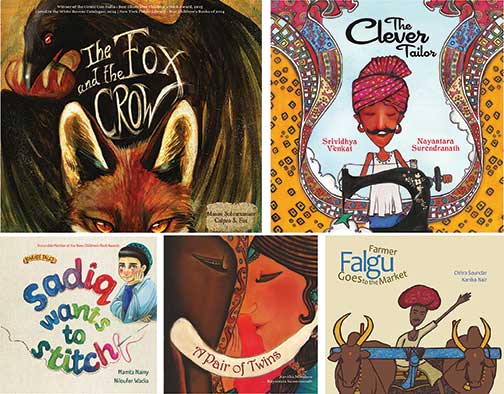Shramana Saha
Playgrounds do wonders for children. They provide opportunities for learning and development, and pave the path for a child’s holistic growth. Picture books can offer similar experiences. Simple yet powerful stories accompanied by illustrations, as also the freedom and exposure available within this world is unparalleled. Along with being incredibly entertaining, these books are essential to a child’s language acquisition and improvement, and for engaging their creativity and imagination.
But don’t all good books do that? How are picture books any different? What picture books have, and other genres lack, is the incorporation of art as text. As children, the first contact we have with the outer world is through images. Be it a car indicating a trip to our grandparents’, or the evening puja paraphernalia telling us it’s time for dinner – we start communicating visually ever since we learn to focus our eyes on things. In fact, so potent are images as means of communication, that a sub-category of picture books is wordless!
Introducing the world of art
It is of great comfort to see children’s publishing in India diverting a large part of their attention to picture books and the exploration of various art forms and styles. Karadi Tales stands out in this regard as one of the forerunners in the field. Ever since the house’s inception in 1996, we have been steadily incorporating traditional art styles like Warli and Madhubani, along with styles and forms of contemporary Indian artists.

Cultivating the love for reading
Handing a child a picture book instead of a chapter book is more effective in introducing them to reading. The cover-to-cover vibrant illustrations (not to be confused with comics) draw children in and get them excited about exploring the book. Even a passive perusal of the book demands an active participation on the part of the child, since the illustrations themselves form a part of the narration. Now, because the art does not reveal the entire story, children would want to instinctively refer to the accompanying written text to fill the gaps in their understanding. And voila, you have a reading child in no time!
Picture books are more effective in developing vocabulary too. Rhyme and refrain have for generations helped in language acquisition – a catchy rhyme or a repeating, often ostensibly silly, phrase is easily remembered by a child. Those words then become readily usable in everyday speech and communication. Moreover, being associated with pictures, words become easier to identify, remember, and recall – remember the connection between images and cognition? What’s more, repetition delights children and fortifies their participation in the reading process. Knowing that a repeated line is just a page flip away makes children feel more than mere observers of the story.
The format of some books involves children in the story in more ways:
• One Rainy Day, Shobha Viswanath (concept book for numbers)
• Cat, Come Back!, Lavanya Karthik (accordion book)
• Lion’s Feast, Lavanya Karthik (write-your-ending book)
• The Insect Boy, Shobha Viswanath (two-way book)
• 8653: One Story, Four Endings, Soumitra Ranade and Rudradutt Ranade (multiple endings)
Honing imagination and creativity
The illustrations, as I mentioned earlier, only tell part of the story. The two – the written and the artistic – halves of the text complement and complete each other’s narratives. Picture books thus become an exercise in creativity and discovery, enhancing cognitive skills in children. Interestingly, the open-endedness of the genre gives children the luxury to be free with their own ideas, perspectives, and understanding when it comes to reading. The scope to explore is manifold – and that’s not just for one child, or one frame of thought; different children get to experience the book in multiple ways respectively because of the inherently layered structure of the books. Isn’t the picture book sounding more and more like a playground by now?
Here are a few of the many interesting books out there:
• Leopard in Mumbai, Lubaina Bandukwala
• Ammachi’s Amazing Machines, Rajiv Eipe
• A Tangle of Brungles, Shobha Viswanath
• Elephants Never Forget, Anushka Ravishankar
• Machher Jhol: Fish Curry, Richa Jha

Building empathy and community
Finally, picture books are a great pathway to the world beyond the children’s homes and classrooms, family and friends. These books bring forth people and children from different cultures and walks of life. The illustrations build familiarity with the otherwise unknown experiences. Understanding and empathizing with these varied characters shapes the children’s emotional intelligence and maturity.
Some books that deal with sensitive topics delicately:
• Paati’s Rasam, Janaki Sabesh and Dhwani Sabesh (death in the family)
• Jamlo Walks, Samina Mishra (plight of migrant workers)
• Dancing Bear, Manasi Subramaniam (animal welfare)
• Aai and I, Mamta Nainy (cancer survival)
• A Pair of Twins, Kavitha Mandana (female empowerment)
What’s more, reading picture books together in the classroom or among peer groups can foster a sense of community and provide a shared experience for children. And because the picture book has such fluidity to it, it also renders itself to great storytelling sessions – every story can be reinvented multiple times, and neither the storyteller nor the children would ever get bored!
The author is a Junior Editor at Karadi Tales. She can be reached at shramana@karaditales.com Karadi Tales is an independent Indian children’s publishing house based out of Chennai, founded in 1996.
